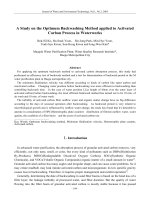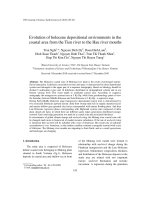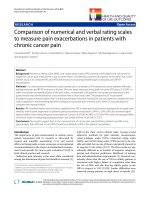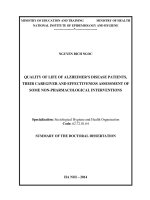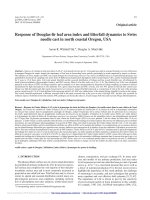Studying and Evaluating the Ability to form Carbon Sinks in Biomass of the Pure Sonneratia caseolaris Plantation in the Coastal Area of Tien Lang district, Hai Phong city
Bạn đang xem bản rút gọn của tài liệu. Xem và tải ngay bản đầy đủ của tài liệu tại đây (321.27 KB, 9 trang )
<span class='text_page_counter'>(1)</span><div class='page_container' data-page=1>
39
Studying and Evaluating the Ability to form Carbon Sinks in
<i>Biomass of the Pure Sonneratia caseolaris Plantation in the </i>
Coastal Area of Tien Lang district, Hai Phong city
Nguyen Thi Hong Hanh
*<i>Ha Noi University of Natural Resources and Environment, 41A Phu Dien, Hanoi, Vietnam </i>
Received 30 November 2016
Revised 13 December 2016; Accepted 23 March 2017
<i><b>Abstract: An evaluation study on the ability of mangrove Sonneratia caseolaris aged 10, 11, and </b></i>
13 years old in the coastal area of Tien Lang district, Hai Phong city in carbon sequestration in
standing biomass following the guidance of IPCC (2006) was conducted to provide a basis for
<i>assessing the role of Sonneratia caseolaris plantation in greenhouse gas reduction and climate </i>
change response as well as to provide a scientific basis and information for international
negotiations under programs of greenhouse gas reduction such as REDD and REDD+ program,;
<i>the study is based on the total and component (leaves, stems, branches and roots) biomass of 72 S. </i>
<i>caseolaris sample trees collected from 9 sample plot (each plot has an area of 100 m</i>2) of
<i>S.caseolaris plantation aged 10, 11 and 13 years old in 2014 - 2015. The results show that carbon </i>
stock in forest biomass reached the highest value in the 13 year-old forest (43.37 tonnes/ha),
followed by the 11-year-old forest with 34.77 tonnes/ha; the lower value was seen in the
10-year-old forest at 32.69 tons/ha. The 10-year-10-year-old forest accumulated 4.81 tonnes/ha/year (corresponding
to 17.65 tonnes of CO2/ha/ year), the figures for the 11-year-old and 13 year-old forests were 5.18
tonnes/ha/year (equivalent to the amount of CO2 of 19.01 tons/ha/year) and 5.52 tonnes/ha/year
(equivalent to the amount of CO2 of 20.26 tonnes/ha/year) respectively. The amount of carbon
accumulated in forest tree corresponding to the amount of CO2 sequestered by forest trees is very
high, which is of significance to reducing the amount of CO2 in the atmosphere, contributing to
mitigating greenhouse gas emissions, and responding to climate change. The great ability of
forests to store carbon is a highly important element for the implementation of REDD, REDD+
programs in Viet Nam.
<i>Keywords: Sonneratia caseolaris, accumulated carbon, greenhouse gas, mangroves forest, carbon credit. </i>
<b>1. Introduction</b>
Climate change is one of the great
challenges of human beings in the twenty-first
century. One of the solutions to minimize
climate change is reducing emissions from
deforestation in developing countries (REDD)
and reducing emissions from deforestation and
_______
Tel.: 84-989965118.
Email:
forest degradation in developing countries, and
the role of conservation, sustainable
management of forests, and enhancement of
forest carbon stocks in developing countries
(REDD+). Viet Nam is among the countries
joining REDD, REDD+ programs and required
to needs to calculate its forest carbon stocks
(Nguyen Quang Tan, 2011) [8].
</div>
<span class='text_page_counter'>(2)</span><div class='page_container' data-page=2>
greenhouse gas emissions, including the CO2
emissions from degradation and deforestation.
There are five forest carbon pools that are
identified: 1) above ground biomass (AGB), 2)
below ground biomass (BGB), 3) litter, 4) dead
wood) and 5) soil ( IPCC, 2006) [5]. Currently
in Vietnam, there are limited quantitative
studies of mangrove carbon stocks to assess the
ability of mangroves to create carbon sinks that
follow the approach under the guidance of
international organizations such as IPCC (2006)
and CIFOR (2012).
Hai Phong is a coastal city; it has about
18,280 ha of forest (natural forests 10,773 ha
and planted forests 7,507 ha). Plantations here
<i>are mainly Kandelia obovata, Sonneratia </i>
<i>caseolaris (Ministry of Agriculture and Rural </i>
Development, 2016) [1].
The present study was carried out to
<i>evaluate the role of planted Sonneratia </i>
<i>caseolaris in the coastal area of Tien Lang </i>
district, Hai Phong city in reducing greenhouse
gases and to provide scientific basis and
information for international negotiations on
programs to cut greenhouse gas emissions, such
as REDD, REDD+ in Vietnam.
<b>2. Materials and methods </b>
<i>2.1. Study objects, sites and time </i>
The study was conducted from 2014 to
<i>2016 in a planted Sonneratia caseolaris on mud </i>
flats grown in 2000 (13 year old forest - R13T),
2002 (11 year old forest - R11T), and 2003 (10
year old forest - R10T) in Dong Hung
commune, Tien Lang district, Hai Phong city
(figure 1). The total area is about 132 ha. The
10-year-old stand has an average density of
1570 trees/ha, 11-year-old forest 1460 trees/ha,
and 13-year-old forest 1490 trees/ha.
</div>
<span class='text_page_counter'>(3)</span><div class='page_container' data-page=3>
<i>2.2. Study method </i>
<i>2.2.1. Setting sample plots </i>
The 09 sample plots were set up from the
dykes seaward, perpendicular to the seadykes;
being close to the seadyke was the 13 year old
mangrove stand; next come the 11 year old
stand followed by the 10 year old stand. In the
forest of each age, 3 sample plots were
established, 100 m2 (10m x 10m) in size each;
the average distance between plots is 100m
(figure 2).
Figure 2. Experimental setting for sampling.
<i>2.2.2. Biomass sampling and analyzing </i>
Research on tree biomass is the basis for
determining the carbon content of the trees.
Tree biomass includes above ground biomass
(leaves, stems, branches ...) and below-ground
biomass (roots) [4, 9].
A total of 4 tree biomass samplings were
taken in 2 years (2014-2016). For each
sampling, two trees of medium size in each
sample plot were cut; all the roots were also
digged out. A total number of sample trees is
72.
Each sample tree was divided into parts:
stems, branches, leaves and roots. Fresh weight
of each tree part was scaled, based on which the
fresh weight of the tree was calculated. For
each tree part, 100 g of fresh sample was taken,
and dried at 1050C for stems and branches and
at 850C for the other parts until the constant dry
weight.
Tree biomass is the total dry weight of tree
parts of individual trees; mangrove stand
biomass is the individual tree's biomass
multiply stand tree density.
<i>2.2.3. Analysis and calculation of carbon content </i>
Carbon content (%) in the tree was
determined by Chiurin method. The total
number of samples for carbon content analysis
is 72 sample trees * 4 tree parts (leaves, stems,
branches and roots)/sample tree = 288 samples
Carbon accumulated in each part of plant
was determined by the carbon content (%) and
dry weight of each part of the tree. The total
carbon accumulated in a tree is determined by
total carbon content of above-ground parts
(leaves, stems, branches...) and below-ground
part (roots) of the tree.
</div>
<span class='text_page_counter'>(4)</span><div class='page_container' data-page=4>
The carbon stock in biomass helped infer
the corresponding CO2 absorbed by standing
trees generating which is calculated by carbon
accumulated in trees (ton/ha) x 3.67 (3.67 is the
constant applied to all types of forests) (Nguyen
Hoang Tri, 2006) [10], (Kaffman JB, et al.) [6].
<i>2.2.3. Statistical analysis and data processing </i>
All data collected were processed by
mathematical statistical method such as
determination of mean value, standard deviation,
and errors within the confidence interval.
<b>3. Results and discussion </b>
<i>3.1. Amount of carbon in above, below ground </i>
<i>and total biomass of Sonneratia caseolaris </i>
<i>trees aged 10, 11, and 13 years old </i>
Plant/tree biomass is the content of organic
matters that are accumulated in plant tissues,
such as stems, branches, leaves, roots ...,
through photosynthesis process [4]. Biomass is
also called as the content of organic carbon
accumulated in trees/plants. From the results of
our research on biomass, we can identify
amount of carbon accumulated in tree biomass.
Amount of carbon accumulated in
above-ground biomass (leaves, branches, stems),
below-ground biomass (roots) and the total
biomass of the trees increased with tree age;
amount of carbon accumulated in biomass was
the highest in the 13 year old forest followed by
the 11 year old forest and then 10 year old
forest (table 1).
<i>Table 1. The amount of carbon accumulated in parts of Sonneratia caseolaris trees </i>
aged 10, 11, and 13 years old
Leaves (kg/tree) Stems (kg/tree) Branches (kg/tree) Root (kg/tree)
Tree
age
Planting
year
Biomass Carbon
content Biomass
Carbon
content Biomass
Carbon
content Biomass
Carbon
content
Carbon
accumulated
in trees
(kg/tree)
10 2003 0.54 0.29 19.81 9.93 14.32 6.97 7.23 3.63 20.82
11 2002 0.63 0.33 23.42 11.68 15.98 7.83 7.87 3.98 23.82
13 2000 2.86 1.46 27.64 13.58 19.05 9.38 8.76 4.41 29.10
The average amount of carbon in the
10-year-old tree was 20.82 kg/tree, followed by the
11-year-old trees with 23.82 kg/tree and the
highest was seen in 13-year-old trees with
29.10 kg/tree. The study results are consistent
with the rules of growth and development of
plants, i.e. tree biomass increases with tree age.
Amount of carbon in biomass of above
ground parts and below ground part was not
even. For above-ground parts of trees, the
carbon was mainly accumulated in tree stems
(9.93 to 13.58 kg/tree), followed by that of
branches (6.97 to 9.38 kg/tree), the figure for
leaves was 0.29 to 1.46 kg/tree. Amount of
carbon in root biomass did not vary much
among different tree ages.
In general, amount of carbon in
above-ground biomass of trees was higher than in
below-ground biomass. The present results are
similar to those of my previous study on the
<i>content of carbon accumulated in trees of K. </i>
<i>obovata aged 10, 11, and 13 years old and </i>
</div>
<span class='text_page_counter'>(5)</span><div class='page_container' data-page=5>
<i>3.2. Carbon stock in above-ground, </i>
<i>below-ground and total biomass of S. caseolaris </i>
<i>stands aged of 10, 11, and 13 years old </i>
It can be seen that similar to the carbon
accumulation in tree, amount of carbon in
above-ground and below-ground biomass of
<i>S.caseolaris stands generally increased with </i>
stand age (table 2).
Table 2. The content of carbon accumulated in above-ground and below-ground biomass
<i>and total biomass of S.caseolaris forest (ton/ha) </i>
Above ground Below ground Total
Stand
age
Density
(trees/ha)
Biomass Carbon
content Biomass
Carbon
content Biomass
Carbon
content
10
year 1570 54.43 ± 2.24 26.99 ± 1.03 11.35 ± 0.59
5.70 ±
0.31 65.78 ± 2.62 32.69 ± 1.18
11
year 1460 58.44 ± 2.56 28.96 ± 1.19 11.49 ± 0.51
5.81 ±
0.27 69.94 ± 2.85 34.77 ± 1.30
13
year 1490 73.99 ± 2.92 36.80 ± 1.43 13.06 ± 0.60
6.57 ±
0.27 87.05 ± 3.15 43.37 ± 1.51
Table 2 shows that the cumulative amount
of carbon in above-ground biomass of the 10
year old stand was the lowest, followed by the
11-year-old stand and the highest was observed
in the 13-year-old stand, being 26.99 tons/ha;
28.96 tons/ha and 36.80 tons/ha respectively.
The carbon accumulated in below-ground
<i>biomass of the S.caseolaris stand aged 13 years </i>
was the highest at 6.57 tons/ha, followed by the
11-year-old forest with 5.81 tons/ha; the lowest
was seen in the 10-year-old forest with 5.70
tons/ha.
Overall, the cumulative carbon in below
ground biomass in the mangrove stands
changed insignificantly, from 0.11 ton/ha to
0.76 ton/ha. However, the carbon accumulated
in above-ground biomass of the population has
increased markedly, from 1.96 tons/ha to 7.84
tons/ha. This proves that when the trees aged
from 10 to 13 years old, they grew mostly in
biomass of leaves, branches and stems. On the
other hand, the 10-year-old trees had closed
canopy of 95%, prioritizing the development of
leaf biomass, increasing the biomass of the CO2
assimilation organs. As for 11 and 13 years old
forests that have completely closed canopies,
natural thinning has occurred intensively; and
there have been fewer branches and leaves; the
trees have grown strongly in height due to
competition in natural light.
</div>
<span class='text_page_counter'>(6)</span><div class='page_container' data-page=6>
Figure 3. Amount of carbon in above-ground and below-ground biomass
<i>of S. caseolaris mangroves aged 10, 11, and 13 years. </i>
The comparison of the amount of carbon
<i>accumulated in total biomass of S. caseolaris </i>
<i>stands with that of mixed species stands of K. </i>
<i>obovata and S. caseolaris [3] indicates that at </i>
the same age of 10,11 and 13 years, the amount
of carbon accumulated in biomass of
<i>S.caseolaris plantations was higher. The carbon </i>
accumulated in biomass of the mixed plantation
aged 10 years was 22.36 tons/ha while the
<i>plantation of S.caseolaris aged 10 years was </i>
32.69 tons/ha. Nguyen Hoang Tri (1996) also
<i>concluded that at the same age, S. caseolaris </i>
<i>trees have much greater biomass than K. </i>
<i>obovata trees [9]; therefore, although the </i>
density of mixed spesies stands aged 10 years
<i>old (8784 trees/ha, including 8400 K.obovata </i>
<i>trees and 384 S. caseolaris trees) was higher </i>
<i>than that of the S.caseolaris stand aged 10 years </i>
<i>old (1570 trees/ha), the number of S. caseolaris </i>
trees in the mixed species stand was less than in
<i>the S.caseolaris stands. Thus, the carbon </i>
<i>content in biomass of S.caseolaris was higher </i>
than that of mixed species mangroves.
From the evidence above, it can be
remarked that the amount of carbon
accumulated in mangroves depends on tree
species, age, and planted tree density. The
<i>carbon accumulated in biomass of S. caseolaris </i>
mangroves was higher than that of mixed
<i>species mangroves consisting of K. obovata and </i>
<i>S. caseolaris; this demonstrates the role of S. </i>
<i>caseolaris mangroves in carbon accumulation, </i>
contributing to reducing greenhouse gas
emissions.
<i>3.3. Ability of S. caseolaris mangroves to form </i>
<i>biomass carbon sinks </i>
To assess the ability of mangrove forests
to create biomass carbon sinks, we evaluated
changes in carbon stocks by following equation
(IPCC, 2006) [5].
B = 2 1
2 2
t t
t t
Where: B
: carbon credits for a period of
time
t1: carbon stock measured at time t1
t2: carbon stock measured at time t2
From the results of the study in 2014 and
2015 on the carbon stock in tree and stand
<i>biomass of S.caseolaris mangroves aged 10, 11 </i>
and 13 years old, we evaluated their ability to
create carbon sinks with the results are shown
in table 4.
</div>
<span class='text_page_counter'>(7)</span><div class='page_container' data-page=7>
Table 4. Changes of carbon stocks in above, below ground and total biomass
<i>of pure S. caseolaris mangroves aged 10, 11, and 13 years </i>
13 year-old stand 11 year-old stand 10 year-old stand
Carbon stock Change of
carbon stock Cumulative
carbon
Equivalent
CO2
Cumulative
carbon
Equivalent
CO2
Cumulative
carbon
Equivalent
CO2
2014 34.14 125.29 26.54 97.40 24.96 91.60
2015 39.42 144.67 31.39 115.20 29.01 106.47
Carbon in
above-ground
biomass
Carbon
accumulated
after one year
(ton/ha/year)
5.28 19.38 4.85 17.80 4.05 14.86
2014 6.44 23.63 5.64 20.70 5.32 19.52
2015 6.70 24.59 5.97 21.91 6.07 22.28
Carbon in
below-ground
biomass
Carbon
accumulated
after one year
(ton/ha/year)
0.26 0.95 0.33 1.21 0.75 2.75
2014 40.61 149.04 32.18 118.10 30.28 111.13
2015 46.13 169.30 37.36 137.11 35.09 128.78
Carbon in
total forest
biomass
Carbon
accumulated
after one year
(ton/ha/year)
5.52 20.26 5.18 19.01 4.81 17.65
Table 4 shows that the amount of carbon in
above-ground biomass increased significantly
after 1 year; this is of significance in creating
carbon credits; the figures for the 10, 11 and
13-year-old stands were 4.05 tons/ha/year
(corresponding to the amount of CO2 of 14.86
tons/ha/year absorbed by trees), 4.85
tons/ha/year (equivalent to 17.80 tons/ha/year
of CO2), and 5.28 tons/ha/year (equivalent to
19.38 tons/ha/year of CO2) respectively.
Similarly, the amount of carbon in
below-ground biomass also increased by a certain
amount after one year; the figure for the 10 year
old stand was 0.75 tons/ha/year (equivalent to
2.75 tons of CO2/ha/year), 11-year-old stand
0.33 tons/ha/year (equivalent to 1.21 tons of
CO2/ha/year), the 13-year-old stand 0.26
tons/ha/year (equivalent to 0.95 tons of
CO2/ha/year). Therefore, the 10-year-old stand
had a higher content of carbon in below-ground
biomass than the 11 and 13 year-old stands; this
could be explained that the 10-year-old trees are
in the stage of growth and development. The
13-year-old trees started showing signs of
slower growth, so the carbon content in root
biomass was lower than that of trees aged 10
and 11 years.
Every year, <i>S.caseolaris </i> mangroves
accumulated additional quantities of carbon in
tree biomass, which is significant in generating
carbon credits to participate in REDD+
program; the 10 years old stand sequestered an
additional amount of 4.81 tons/ha/year
(equivalent to the amount of CO2 of 17.65
tons/ha/year), the stand aged 11 years old
accumulated an additional amount of 5.18
tons/ha/year (equivalent to 19.01 tons/ha/ year
of CO2), and the stand aged 13 years old an
additional amount of 5.52 tons/ha/year
(equivalent to the amount of CO2 of 20.26
tons/ha/year).
The amount of carbon stored in mangrove
trees is corresponding to a large amount of CO2
</div>
<span class='text_page_counter'>(8)</span><div class='page_container' data-page=8>
the amount of CO2 in the atmosphere,
contributing to reducing greenhouse gas
emissions and climate change response [2, 7,
10]. The great ability of mangroves to
accumulate carbon is an important element for
the implementation of REDD, and REDD+
programs in Viet Nam.
<b>4. Conclusions </b>
In the present condition, carbon stock in
<i>biomass of S.caseolaris mangroves increased </i>
with increasing stand age, reaching the highest
value in the 13-year-old stand with 43.37
tons/ha (the accumulated carbon in
above-ground and below-biomass of the forest was
36.80 tons/ha and 6.57 tons/ha respectively.
Next came the 10-year-old stand with 32.69
tons/ha (content of carbon accumuled in
above-ground and below-above-ground biomass of the forest
was 26.99 tons/ha and 5.70 tons/ha
respectively) and the 11-year-old stand with
34.77 tons/ha (content of carbon accumuled in
above-ground and below-ground biomass of the
forest was 28.96 tons/ha and 5.81 tons/ha
respectively).
Annually, <i>S.caseolaris </i> <i>mangroves </i>
accumulated an additional amount of carbon in
trees biomass, which is significant in generating
carbon credits; the 10-year-old stand added an
cumulative amount of 4.81 tons of
carbon/ha/year (corresponding to the amount of
CO2 of 17.65 tons/ha/year); the mangroves aged
11 years accumulated additional 5.18 tons of
carbon/ha/year (equivalent to the amount of
CO2 of 19.01 tons/ha/year), and the mangroves
aged 13 years 5.52 tons of carbon/ha/year
(equivalent to the CO2 amount of 20.26 tons/
ha/year).
The carbon accumulated in mangrove trees
was corresponding to the great amount of CO2
absorbed by trees; this is of significance in
reducing the amount of CO2 in the atmosphere,
contributing to mitigating greenhouse gas
emissions and climate change response. The
high ability of mangroves to accumulate carbon
is an important element for the implementation
of REDD, REDD+ programs in Viet Nam.
<b>References </b>
[1] Ministry of Agriculture and Rural Development,
2016. Decision No. 3158/QD-BNN-TCLN dated
July 27, 2016 of the Minister of Agriculture and
Rural Development on Announcement of Forest
Status in 2015.
[2] Nguyen Thanh Ha, Yoneda R., Ninomiya I.,
Harada K., Tan D. V., Tuan M. S., Hong P. N.,
2004. The effects of stand-age and inundation on
the carbon accumulation in soil of mangrove
plantation in Namdinh, northern Vietnam, The
Japan society of tropical ecology, 14: 21-37.
[3] Nguyen Thi Hong Hanh, 2015. Quantitative study
on carbon in the mixed forest of two mangrove
species in Nam Phu commune, Tien Hai district,
Thai Binh province, Magazine of Biology, volume
37, issue 1, pp.39-45.
[4] Phan Nguyen Hong (ed.), Tran Van Ba, Vien
Ngoc Nam, Hoang Thi San, Le Thi Tre, Nguyen
Hoang Tri, Mai Sy Tuan, Le Xuan Tuan, 1997.
The role of mangroves in Viet Nam, planting and
caring techniques, Ha Noi Agriculture Publishing
House, pp.74-92
[5] IPCC, 2006. IPCC Guidelines for National
Greenhouse Gas Inventories, Prepared by
National Greenhouse Gas Inventories Programme,
Eggleston H.S., Buendia L., Miwa K., Ngara T.,
Tanabe K., (eds). Published: IGES, Japan.
[6] Kauffman J. B., & Donato D., 2012. Protocols for
the measurement, monitorring and reporting of
structure, biomass and carbon stocks in mangrove
forests. Bogor, Indonesia: Center for International
Forestry Research (CIFOR).
[7] Sathirathai S., 2003. Economic valuation of
mangroves and the roles of local communities in
the conservation of natural resources: Case study
of Surat Thani, South of Thailand, Research
Report, pp. 68-81.
[8] Nguyen Quang Tan , 01/Dec/2011. Overview of
REDD+ process in Viet Nam, RECOFTC – Centre
for Human and Forests, .
[9] Nguyen Hoang Tri, 1996. Plants of mangroves in
Viet Nam, Ha Noi Printing Technical School
Publisher, 79pps.
</div>
<span class='text_page_counter'>(9)</span><div class='page_container' data-page=9>
Nghiên cứu, đánh giá khả năng tạo bể chứa Cacbon trong sinh
khối của Rừng ngập mặn trồng thuần loài bần chua
<i>(Sonneratia caseolaris) ven biển huyện Tiên Lãng, </i>
thành phố Hải Phòng
Nguyễn Thị Hồng Hạnh
<i>Trường Đại học Tài nguyên và Môi trường Hà Nội, 41A Phú Diễn, Hà Nội, Việt Nam </i>
<i><b>Tóm tắt: Để có cơ sở đánh giá vai trị của rừng ngập mặn trồng thuần lồi bần chua (Sonneratia </b></i>
<i>caseolaris) 10, 11, 13 tuổi ven biển huyện Tiên Lãng, thành phố Hải Phịng trong việc giảm khí nhà </i>
kính, ứng phó với biến đổi khí hậu, đồng thời cung cấp cơ sở khoa học cho việc đàm phán quốc tế
trong các chương trình thực hiện cắt giảm khí nhà kính như REDD; REDD+, chúng tôi nghiên cứu;
đánh giá khả năng tạo bể chứa cacbon trong sinh khối của rừng theo hướng dẫn của IPCC (2006), dựa
trên số liệu sinh khối của 72 cây bần chua được thu thập tại 9 ô tiêu chuẩn (mỗi ô tiêu chuẩn có diện
tích là 100 m2) của rừng 10 tuổi, 11 tuổi và 13 tuổi (24 cây/rừng) và phân tích hàm lượng cacbon trong
các bộ phận lá, thân, cành, rễ của 72 cây (tương ứng với 288 mẫu) trong hai năm từ 2014 - 2015. Kết
quả nghiên cứu cho thấy, lượng cacbon tích lũy trong sinh khối của rừng đạt giá trị cao nhất là rừng 13
tuổi với 43,37 tấn/ha, tiếp theo là rừng 11 tuổi với 34,77 tấn/ha, thấp nhất là rừng 10 tuổi với 32,69
tấn/ha. Hàng năm, rừng trồng thuần loài bần chua tích lũy thêm một lượng cacbon trong sinh khối cây
và rừng, điều này có ý nghĩa quan trọng trong việc tạo tín chỉ cacbon, rừng 10 tuổi tích lũy 4,81
tấn/ha/năm (tương ứng với lượng CO2 là 17,65 tấn/ha/năm), rừng 11 tuổi tích lũy 5,18 tấn/ha/năm
(tương ứng với lượng CO2 là 19,01 tấn/ha/năm), rừng 13 tuổi tích lũy 5,52 tấn/ha/năm (tương ứng với
lượng CO2 là 20,26 tấn/ha/năm). Lượng cacbon tích lũy trong cây rừng tương ứng với lượng CO2 do
cây rừng hấp thụ là rất lớn, điều này có ý nghĩa làm giảm lượng CO2 trong bầu khí quyển, góp phần
giảm khí thải nhà kính, ứng phó với biến đổi khí hậu. Khả năng tích lũy cacbon cao của rừng là yếu tố
quan trọng để thực hiện các chương trình REDD, REDD+ tại Việt Nam.
<i>Từ khóa: Sonneratia caseolaris, cacbon tích lũy, khí nhà kính, rừng ngập mặn, tín chỉ cacbon. </i>
</div>
<!--links-->
